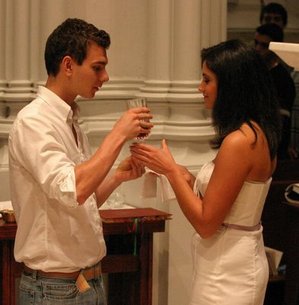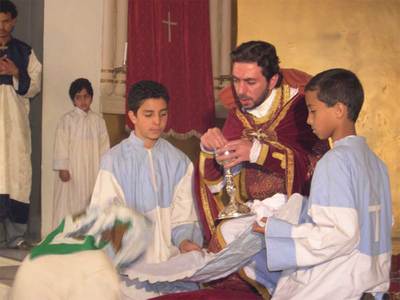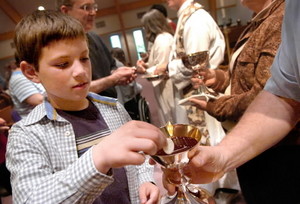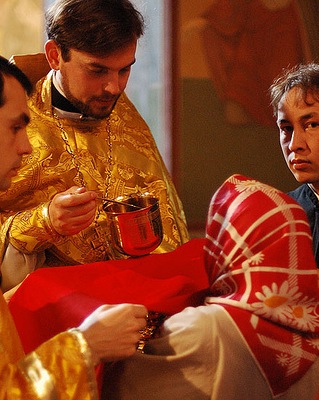Let us test and examine our ways
Again: Time for An Intervention
I originally wrote this post last September, saying that my heart was heavy because it had been brought to my attention that “accidents” during the distribution of Holy Communion under both species occur not infrequently in parishes, i.e., the Most Precious Blood is spilled during the administration of Holy Communion from the chalice. Recently I learned of other such “accidents.” And so I decided to post this entry again.
Even if such “accidents” occur no more than twice or three times a year in a given parish, they give sufficient reason to review, and, I should think, modify the manner in which the Most Precious Blood is distributed.

The use of this photo is in no way a reflection on the good faith of the young people appearing in it. It does, however, effectively demonstrate the great chasm that has opened up between the liturgical practice of the Eastern Churches (see the photo above) and certain liturgical practices that are currently widespread in churches of the Roman Rite. It also demonstrates that some members of the clergy have failed to address the legitimate hopes and praiseworthy aspirations of the faithful, by neglecting to offer a consistent mystagogical catechesis (explanation of the unfolding of the liturgical rites and texts), capable of fostering true, conscious, and actual participation in the Holy Sacrifice of the Mass, in accordance with liturgical law and in organic continuity with tradition.
A few questions?
Are these incidents reported directly to the Ordinary, so that the he can, when necessary, limit Holy Communion under both forms, and exercise vigilance over the manner in which it is carried out?
Should not parish priests be required to submit to their Ordinary a yearly report of any such incidents, so that the Ordinary, taking into account their number and frequency, can revise existing policies and promulgate suitable stricter norms for his diocese?
Why is there no critical review of a practice that, in fact, poses serious problems of irreverence?
Why are certain passages of Pope Paul VI’s Sacramentali Communione (29 June 1970) systematically ignored? I give the relevant passages here in boldface:
Among the ways of communicating prescribed by the General Instruction of the Roman Missal, receiving from the chalice itself ranks first. Even so, it is to be chosen only when everything can be carried out in fitting order and with no danger of irreverence toward the Blood of Christ. When they are available, other priests or deacons or even acolytes should be chosen to present the chalice. The method of communicating in which the communicants pass the chalice to one another or go directly to the chalice to take Christ’s Blood must be regarded as unacceptable.
Whenever none of the ministers already mentioned is available, if the communicants are few and are to receive communion under both kinds by drinking directly from the chalice, the priest himself distributes communion, first under the form of bread, then under the form of wine.
Otherwise the preference should be for the rite of communion under both kinds by intinction: it is more likely to obviate the practical difficulties and to ensure the reverence due the sacrament more effectively. Intinction makes access to communion under both kinds easier and safer for the faithful of all ages and conditions; at the same time it preserves the truth present in the more complete sign.
Why is this clear statement in favour of Holy Communion by intinction systematically ignored?

Both Orthodox and Eastern Catholic rites have, for centuries, practiced a form of Holy Communion by intinction? Latin Rite Catholics have something to learn from this centuries-old experience.
From Redemptionis Sacramentum:
[103.] The norms of the Roman Missal admit the principle that in cases where Communion is administered under both kinds, “the Blood of the Lord may be received either by drinking from the chalice directly, or by intinction, or by means of a tube or a spoon”.[191] As regards the administering of Communion to lay members of Christ’s faithful, the Bishops may exclude Communion with the tube or the spoon where this is not the local custom, though the option of administering Communion by intinction always remains. If this modality is employed, however, hosts should be used which are neither too thin nor too small, and the communicant should receive the Sacrament from the Priest only on the tongue.[192]
[104.] The communicant must not be permitted to intinct the host himself in the chalice, nor to receive the intincted host in the hand. As for the host to be used for the intinction, it should be made of valid matter, also consecrated; it is altogether forbidden to use non-consecrated bread or other matter.
Have our Bishops given thought to the grave scandal given to the Orthodox Churches by the current Roman Catholic practices of Extraordinary Ministers of Holy Communion, often in casual street attire, distributing the Most Precious Blood directly from the the chalice without so much as a cloth held beneath the chin of the communicant?

Why are Protestants not offended by the same practice? Why are they indifferent to it? The answer is, I think, obvious.
Has Holy Communion under both forms been used as a justification for the multiplication of Extraordinary Ministers of Holy Communion?
In the choice of Extraordinary Ministers of Holy Communion, why are the principles and the order for selection of fit persons indicated in Immensae Caritatis (29 January 1973) not followed? Alas, there are even parishes where an open appeal for volunteers is made from the pulpit!
With regard to the first, we read that Extraordinary Ministers of Holy Communion may be employed:
a. whenever no priest, deacon, or acolyte is available;
Why are acolytes (now, effectively equivalent to subdeacons in the reformed Latin Rite) not employed?
Why have Ordinaries not instituted a course of preparation for acolytes, similar to that in place for deacons?
Why are men preparing for the permanent diaconate, who have already been instituted as acolytes, not preferred to Extraordinary Ministers of Holy Communion?
b. whenever the same ministers are impeded from administering communion because of another pastoral ministry, ill-health, or old age;
Should not the Ordinary be consulted before determining that such is, in fact, the case?
c. whenever the number of faithful wishing to receive communion is so great that the celebration of Mass or the giving of communion outside Mass would take too long.
This is frightfully vague and subject to misinterpretation.
What is too great a number of faithful? 20? 50? 100? 300? 500?
Who decides this?
What is “too long”? Who decides this?
Further, we read in the same Instruction Immensae Caritatis:
IV. The fit person referred to in nos. I and II will be designated according to the order of this listing (which may be changed at the prudent discretion of the local Ordinary): reader, major seminarian, man religious, woman religious, catechist, one of the faithful–a man or a woman.
There is an order here.
Why, in practice, do instituted readers (lectors) fall below the radar screen?
Are not deacon candidates (at least those in the final years of formation) “major seminarians”?

A Crisis
It is time to address these questions. The use of Extraordinary Ministers of Holy Communion is completely out of control, as is the distribution of Holy Communion under both forms. The faithful are confused and misled by current practices. It is not uncommon to hear the Most Precious Blood referred to as “the wine” — by some Extraordinary Ministers of Holy Communion themselves!
Might the beginning of a solution not be a “pastoral moratorium” on the appointment of Extraordinary Ministers of Holy Communion and on Holy Communion under both forms until these questions are studied, and suitable remedies mandated by the competent authority?
An Element of Solution: Acolytes
The obvious solution, it seems to me, while waiting for the restoration of the subdiaconate, would be the formation and institution of acolytes in accord with Pope Paul VI’s Motu Proprio Ministeria Quaedam (15 August 1972). Acolytes instituted in accordance with Ministeria Quaedam could, effectively, replace Extraordinary Ministers of Holy Communion, and contribute to the resacralization of the ministration of the Holy Mysteries. They could, at solemn celebrations, be vested in amice, alb, cincture, and tunicle; in less solemn celebrations they would vest in cassock and surplice, or otherwise, in amice, alb, and cincture.
The acolyte is appointed in order to aid the deacon and to minister to the priest. It is his duty therefore to attend to the service of the altar and to assist the deacon and the priest in liturgical celebrations, especially in the celebration of Mass; he is also to distribute communion as a special minister when the ministers spoken of in the Codex Iuris Canonici, can. 845 are not available or are prevented by ill health, age, or another pastoral ministry from performing this function, or when the number of communicants is so great that the celebration of Mass would be unduly prolonged. In the same extraordinary circumstances an acolyte may be entrusted with publicly exposing the Blessed Sacrament for adoration by the faithful and afterward replacing it, but not with blessing the people. He may also, to the extent needed, take care of instructing other faithful who on a temporary basis are appointed to assist the priest or deacon in liturgical celebrations by carrying the missal, cross, candles, etc., or by performing other such duties. He will perform these functions more worthily if he participates in the Holy Eucharist with increasingly fervent devotion, receives nourishment from it, and deepens his knowledge about it.
As one set aside in a special way for the service of the altar, the acolyte should learn all matters concerning public Divine Worship and strive to grasp their inner spiritual meaning: in that way he will be able each day to offer himself entirely to God, be an example to all by his gravity and reverence in church, and have a sincere love for the Mystical Body of Christ, the people of God, especially for the weak and the sick.
(Ministeria Quaedam VI)
Therefore, whosoever shall eat this bread, or drink the chalice of the Lord unworthily, shall be guilty of the body and of the blood of the Lord. But let a man prove himself: and so let him eat of that bread and drink of the chalice. For he that eats and drinks unworthily eats and drinks judgment to himself, not discerning the body of the Lord. Therefore are there many infirm and weak among you: and many sleep. (1 Corinthians 11:27:30)


I’m thrilled about this post Fr. Mark, but how do we make this happen? Could women be acolytes or just men (that would cause a problem in the equality-obsessed west). Furthermore, are there enough men willing to respond to the call of being an acolyte? I suppose if there weren’t, that would be alright because then there wouldn’t be ANY EMHC’s.
Don’t get me wrong, I think this is a great idea, a necessary one, and one that is good for the church, but I just have a hard time seeing it happen soon unless the bishops mandate it, and even then, I think there would be a lot of resistance.
Father, my heart aches to see all of the abuses allowed. The abuses could be stopped if ALL pastors would be courageous and faithful leaders of the flock entrusted to their care–all the more reason to pray much for them!
In a neighboring parish where I attend weekday Mass, the deacon almost never acts as an ordinary minister of the Eucharist. Instead he daily invites members of the congregation to distribute Holy Communion, while he stays in the pew. I have spoken to him and to the pastor about this to no avail. For about 50 people in attendance at Mass, there are always 3 Extraordinary Ministers of Holy Communion (except for the rare occasions when the deacon distributes). A parishioner told me that at one time there were stains on the carpet at the “stations” where the Precious Blood was distributed.
Also, I have asked the deacon to take care when he invites people to act as Extraordinary Ministers to invite people who are modestly dressed, because that has been an issue in that parish. At another parish, a young woman stood next to the priest to distribute Holy Communion at a First Holy Communion Mass. She was wearing a skirt that came to her mid-thigh. She probably just didn’t know better since immodesty is acceptable in our society, and who can remember hearing a sermon about appropriate and modest dress-I can’t.
At my home parish, a woman and a deacon went up at the same time to fill the “needed number” of Eucharistic ministers. When the priest chose the deacon, the lady was offended.
Father, thank God you and others have been inspired to live a life of prayer for priests. The concessions made to human respect are innumerable among priests and also among deacons, religious and laity. It seems more important to be “democratic” and keep everybody happy than to follow Church guidelines that promote proper reverance for Jesus in the Blessed Sacrament.
One final note: I have never seen a person refused Holy Communion by a priest for being very immodestly dressed, or turned away from being a Eucharistic minister for the same reason, but I have seen people frowned upon, scolded or refused Communion for having the audacity to kneel before their God to receive Him in Holy Communion.
Dear Father Mark:
I have read and re-read your words. They weigh heavily upon my soul.
I am just a little nobody yet I have been privileged to be an Extraordinary Minister of the Eucharist to shut-ins. I am honored too to be permitted to expose the Blessed Sacrament for Adoration. These has been great joys to me spiritually!
Yet, even in my little bitty works around the parishes, I can understand the lack of reverence that prevails in many of our Catholic parishioners nationwide.
I am richly blessed to have a priest who is very obedient and faithful to the canonical protocol for the reception of Holy Communion under both species. He is my pastor, and my spiritual advisor, Fr. Tim Davison. He has done much to create a deeper reverence for the celebration of the Mass in our Tulsa parish. I feel so home spiritually with the kneel for communion, reception of the host on the tongue and now Mass Ad Orientem. I am grateful! The Holy Spirit is very present in our parish.
Sadly, though, each of these changes seemed to require so much time for people to let go of what was their previous routine and to allow him to undo the subtle but insidious abuses passed on to us during the past 50 plus years. Old habits die so slowly.
Father Mark, like you, I believe these changes are urgent and we must begin now to make a return to the Sacredness of the Mystery of the Eucharistic Banquet. Yes, it will take many years, but we cannot delay!
Is there anything I can do to help as a little and old lay person? Of course, I will add this to the top of my prayer intention list!
Dear Father Mark,
the last photo you have used shows a to my observation most common abuse of distributing the Holy Blood in my country (Germany). I mean the self-intinction of the Holy Body of Christ in the chalice with the holy blood by the recipient.
I was used to this practice and judged it as when handled carefully by the recipient a good way to consume the Holy Blood without worries about too much contact of several mouths to the chalice as a matter of hygiene.
Can you imagine my shock as I have read the instruction Redemptionis Sacramentum by the Congregation of Divine Worship and the Discipline of the Sacraments(2004)? Especially the No 104 which clearly forbids this practice.
I have never met a catechesis or short instruction before the communion in a mass with distribution in both kinds, which made clear that this practice is abusive. Instead the habitual practice is continued without explanation. My experience is that the mentioning of the knowledge of the existance of this instruction is the best way to be confronted with “pastoral hatred” by many of the ordained ministers perhaps the mayority.
I experienced this hatred before, once as “altar boy” when I whispered to the priest that the has read the postcommunio of the sunday a week before. I was fiercly instructed not to interfere in his freedom to choose the prayer(!), my bad, i though he had opened the book at the wrong page. (see Sacrosantum Concilium art 22 §3). The other oppurtinites were discussions with priests about the history of liturgy around and after Vatican II. I often was told that the council has abrogated the use of the latin, ordered that the mass should be read versus populum etc. My mistake was, that I have read Sacorsanctum Concilium, and that I can’t remember that I have read this, instead I cited the above mentioned paragraph and SC art 36. Confronted with the fact, that I know that they lied, I was instructed, that I can’t judge this correct without a study of theology as they have and that my asking for an explanation is a sign of disobidience to the mother church.
Thank you very much to bring up this grave topic to public.
Please forgive me any linguistical mistake I made, as you might suppose, I am a non-natural english speaker.
Yours in Christ,
Marcus
Dear Father Mark,
It’s hard to have to endure all those abuses that are a “norm” in most (?) parishes anymore.
The Vatican might as well be on a different planet;
the easier it is to communicate (technology, etc), the harder it is for people to hear to what the Holy Father says, or the Scripture.
To put in a literal (physical) and spiritual way, it feels like the Word of God is being crucified during the mass because of the way it is “handled”.
What a far cry from the heavenly liturgies from the Book of Revelation!
Father Mark-
A wonderful posting.
This issue has disturbed my calm for decades. I am anxiously awaiting the new missal and I support all the Reform of the Reform changes that have and hopefully will happen. However, until the Church mandates proper distribution and reception by intinction, I cannot in good conscience participate in a Roman Rite Mass. It was the number 1 reason I became Byzantine, not the only reason but the number 1 reason. I attend Ruthenian, Ukrainian and Melkite Divine Liturgy and am at Peace. I prefer the Melkite form but either Byzantine form is fulfilling.
That picture of the young man and attractive young woman is so offensive; not only can I not tell who is ministering to whom, but their apparel and appearance is vulgar. In fact, it looks like they could be at a college party!
Rome needs to clean up its act. If it can be done with decency and order in the Eastern Churches it can be done in the Western Churches as well.
Father Christopher Phillips at OUR LADY OF THE ATONEMENT CATHOLIC CHURCH administers by intinction not only at the ANGLICAN USE MASS but also when celebrating the NOVUS ORDO. You can find videos of the former on the parish website (or better, buy the DVD) and the latter can be found on You Tube (the N.O. Mass is in 6 parts, very lovely).
Father Mark-
A wonderful posting.
This issue has disturbed my calm for decades. I am anxiously awaiting the new missal and I support all the Reform of the Reform changes that have and hopefully will happen. However, until the Church mandates proper distribution and reception by intinction, I cannot in good conscience participate in a Roman Rite Mass. It was the number 1 reason I became Byzantine, not the only reason but the number 1 reason. I attend Ruthenian, Ukrainian and Melkite Divine Liturgy and am at Peace. I prefer the Melkite form but either Byzantine form is fulfilling.
That picture of the young man and attractive young woman is so offensive; not only can I not tell who is ministering to whom, but their apparel and appearance is vulgar. In fact, it looks like they could be at a college party!
Rome needs to clean up its act. If it can be done with decency and order in the Eastern Churches it can be done in the Western Churches as well.
Father Christopher Phillips at OUR LADY OF THE ATONEMENT CATHOLIC CHURCH administers by intinction not only at the ANGLICAN USE MASS but also when celebrating the NOVUS ORDO. You can find videos of the former on the parish website (or better, buy the DVD) and the latter can be found on You Tube (the N.O. Mass is in 6 parts, very lovely).
You have known me for a LONG time.
In my home parish within the last month, I reverently approached the Blood of Christ with the host in my hands to “use intinction” and was told by the EM in a booming voice that “WE don’t do that here! You can either drink from the cup or move on!” He must have thought I was from one of “those” other denominations. I was astounded by the insensitivity and true lack of reverence for the sacramental moment (mine and others). I was truly floored…
I have an appointment with the pastor. We’ll see how that goes….
Most unfortunate and completely unacceptable behaviour on the part of the Extraordinary Minister of Holy Communion! It demonstrates the breakdown of liturgical catechesis. Pastors of souls must continually catechize the faithful on the Church’s sacred rites, for no detail is without meaning. Holy Communion with intinction by the communicate himself or herself has never been permitted by the Church, although the practice did become widespread. I propose a pastoral moratorium on Communion under both species in order to allow time for a thorough catechesis on the subject that is both accurate and sensitive to the faithful who have been misled and poorly instructed. Here is the official text, Barbara:
From Redemptionis Sacramentum:
[103.] The norms of the Roman Missal admit the principle that in cases where Communion is administered under both kinds, “the Blood of the Lord may be received either by drinking from the chalice directly, or by intinction, or by means of a tube or a spoon”.[191] As regards the administering of Communion to lay members of Christ’s faithful, the Bishops may exclude Communion with the tube or the spoon where this is not the local custom, though the option of administering Communion by intinction always remains. If this modality is employed, however, hosts should be used which are neither too thin nor too small, and the communicant should receive the Sacrament from the Priest only on the tongue.[192]
[104.] The communicant must not be permitted to intinct the host himself in the chalice, nor to receive the intincted host in the hand. As for the host to be used for the intinction, it should be made of valid matter, also consecrated; it is altogether forbidden to use non-consecrated bread or other matter.
As an orthodox and conservative Anglican I am dismayed by Eucharistic practice in both Christian Communities.
1. Communion in the hand. Formerly in our communion this was governed by fairly strict protocol. The right hand was supported by the left and the host placed in it. The head was slightly bowed and the species taken to the mouth. I now observe the terrible practice, common in Roman parishes, of communicants receiving the host and then taking it in the fingers and self communicating.
2. Formerly we received the chalice at the hands of the priest or a person licensed by the bishop. We guided the chalice so that no mishaps would happen. A linen purificator was at hand. I now see persons taking the chalice and self communicating. Intinction now tends to be done by the communicant.
This is theologically important. We, including celebrants, do not give ourselves the Body and Blood of Christ. We receive it as a gift from Christ himself. This is true even of the celebrant and concelebrants, although they are the instrumentality for their own communion..
Distribution and reception should reflect the profound significance of the gift and our profound humility in reception.
Your suggestions are good ones. There is no reason why Communion in Both Species, with its attendant fullness of experience, should be impossible as a reverent act in the Eucharistic community.
How very sad indeed it is to see that Anglicans with invalid orders, who do not actually have a valid consecration have as described above more reverence than most Catholic parishes do today! For them it is unnecessary – due to the lack of Transubstantiation – but present, for us it is truly necessary but wanting!
I cannot help but pray with the Angel at Fatima:
“Most Holy Trinity, Father, Son and Holy Ghost, I adore Thee profoundly. I offer Thee the most precious Body, Blood, Soul and Divinity of Jesus Christ, present in all the tabernacles of the world, in reparation for the outrages, sacrileges and indifferences by which He is offended. By the infinite merits of the Sacred Heart of Jesus and the Immaculate Heart of Mary, I beg the conversion of poor sinners.”